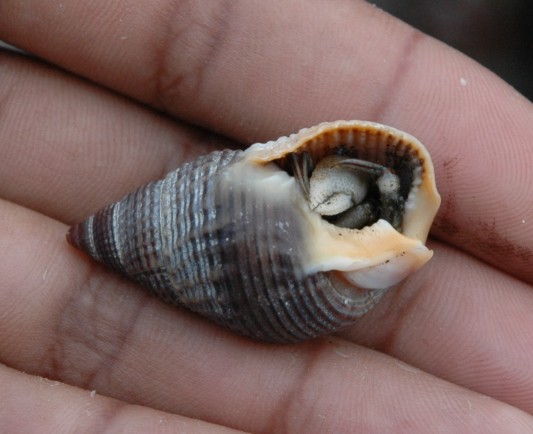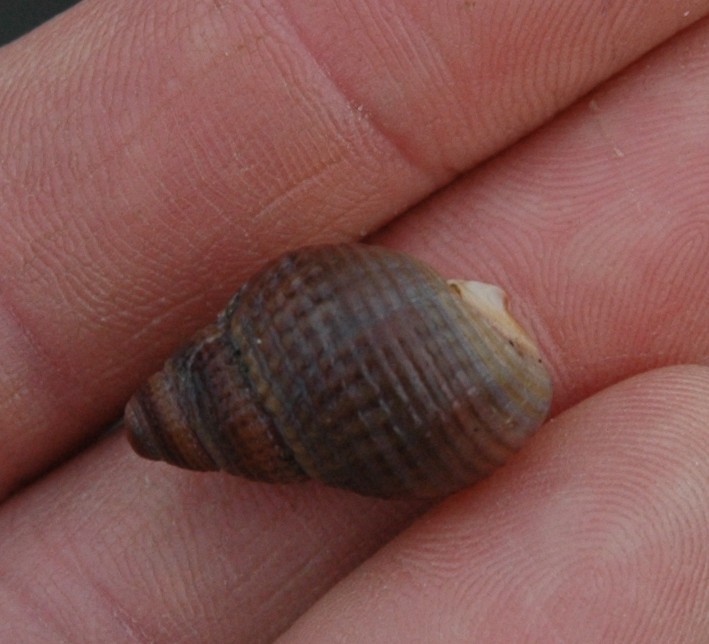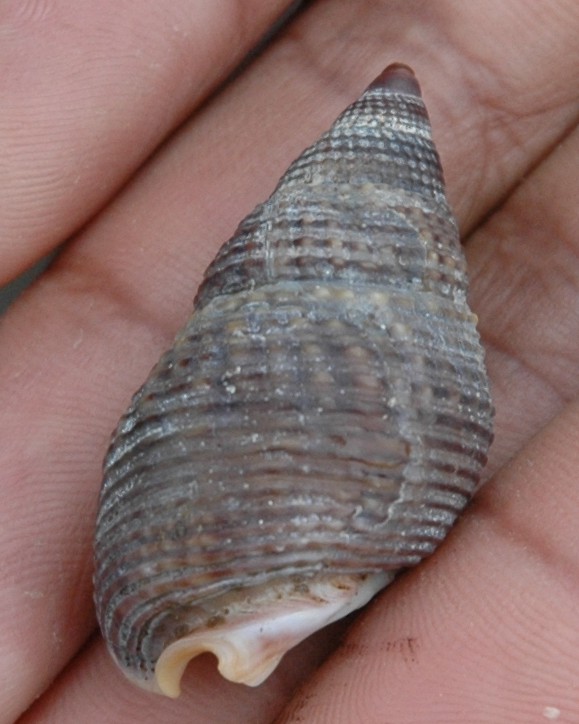Nassarius fossatus (Gould, 1850)Common name(s): Channeled basket whelk, Channeled nassa, Channeled dog whelk, Basket shell, Giant western nassa |
|
| Synonyms: Nassa fossatus, Alectrion fossatus |  |
| Phylum Mollusca
Class Gastropoda Subclass Prosobranchia Order Neogastropoda Suborder Rachiglossa Family Nassariidae |
|
| Nassarius fossatus shell (contains a hermit crab) found intertidally near Rosario. Note the deep groove at the anterior (right) end that separates the anterior end of the body whorl from the rest of the shell. | |
| (Photo by: Dave Cowles July 2006) | |
How to Distinguish from Similar Species: Ilyanassa obsoleta and Searlesia dira do not have the deep anterior groove. Nassarius fraterculus has spiral ridges only on the body whorl. Several other species have axial ribs which reach to the angerior groove. Of these, N. mendicus has much more pronounced axial ribs than spiral ridges, while N. rhinites and N. perpinguis have small axial ribs and spiral ridges which intersect to form distinct beads (may need magnification to see).
Geographical Range: Vancouver Island, B.C. to Laguna San Ignacio, Baja California. This is the most common carnivorous snail on mud flats along the US west coast. It is most common in the northern parts of its range.
Depth Range: Low intertidal to 18 m
Habitat: Intertidal and more commonly subtidal on sandy areas and mud flats.
Biology/Natural History: Feeds as a predator or primarily a scavenger. Can crawl well on rock, or on top of or just below the surface of sand or mud. They crawl with both sides of the large foot, leaving a distinctive track in the sand. Attracted from long distances by rotting meat, which it can smell with its long proboscis. It can crawl rapidly. When feeding, it wraps its foot completely around the food until it is consumed. May also drill in clams or snails. Predators include the seastar Pisaster brevispinus. When contacted by P. brevispinus, N. fossatus may writhe so violently with its foot that it twists into somersaults and even vaults into the water column. At other times it may simply turn and crawl swiftly away, rocking its shell back and forth. Sometimes the colonial hydroid Clytia bakeri, which is one of few hydroids that grow on exposed sandy shores, is found growing on shells of this species. Deposits its egg capsules on eelgrass or other firm objects in mud flats in late winter and spring. A typical string of eggs may be 6 cm long and contain 45 eggs. The individual capsules are about 3 mm long. They are laid overlapping one another to produce a "shingled" appearance.
The wicker-basketlike appearance of the intersecting radial
ribs and
spiral ridges is the reason this species is called a basket whelk.
| Return to: | |||
| Main Page | Alphabetic Index | Systematic Index | Glossary |
References:
Dichotomous Keys:Griffith, 1967
Kozloff 1987, 1996
Smith and Carlton, 1975
General References:
Brusca
and Brusca, 1978
Harbo,
1997
Hinton,
1987
Kozloff,
1993
McConnaughey
and McConnaughey, 1985
Morris,
1966
Morris
et al., 1980
Niesen,
1994
Niesen,
1997
Ricketts
et al., 1985
Sept,
1999
Scientific Articles:
Web sites:
General Notes and Observations: Locations, abundances, unusual behaviors:

The outer margin of the aperture has small teeth on the margin and
is ridged inside. It has a short siphonal notch or canal at
the anterior
end (right above) and a small notch at the posterior end.
The innr margin and columella have alarge callus which is usually
orange.
This shell has a hermit crab inside.

Another, smaller individual

This anterior view of the shell clearly shows the groove which sets
off the anterior end from the rest of the shell.
Authors and Editors of Page:
Dave Cowles (2006): Created original page